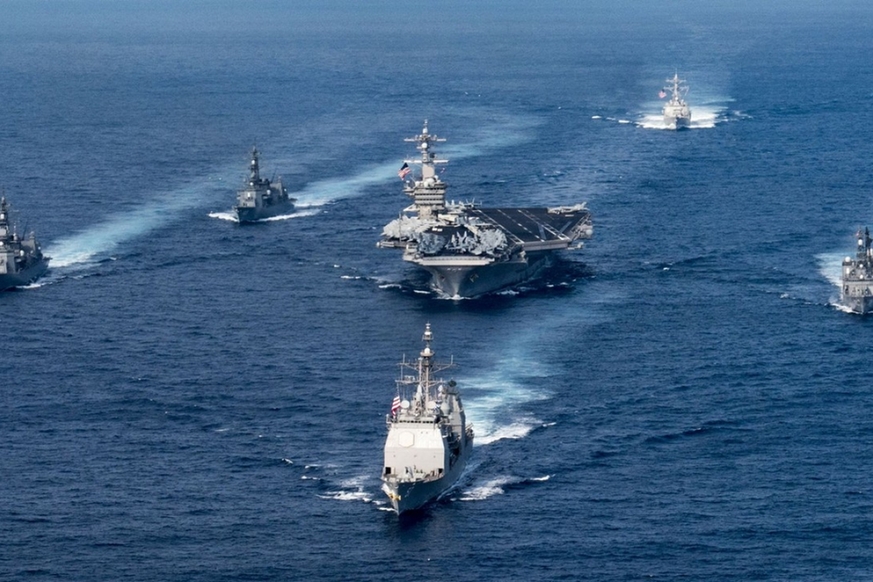
By Wu Shicun
The COVID-19 pandemic has hit the US hard and seriously disrupted the US military’s combat readiness and deployments. It is reported that the pandemic has spread to at least 150 US military bases and four aircraft carriers, yet this hasn’t slowed down the US military in seeking domination on the West Pacific through military means. Rather, it has kept on making waves in the South China Sea.
Why has the US military intensified its moves in the South China Sea while its combat force is weakened by the COVID-19 outbreak? The first National Security Strategy report released by the Trump administration in 2017 defined China as a “strategic competitor”, followed by the “Indo-Pacific strategy” that highlighted the importance of the South China Sea issue in the China-US security game. From the perspective of the US, the South China Sea is indispensable for maintaining its maritime domination on the West Pacific, because it is a critical waterway to pursue US maritime hegemony, and also an important leverage to curb China’s rise and suppress the development of Chinese maritime forces.
From China’s perspective, however, the South China Sea is a matter of national sovereignty, security and development interests, a natural shield of national security and a strategic sea route. Therefore, the South China Sea game is endowed with strategic and structural features. Beijing will never believe that Washington would slack its moves in the region because of the outbreak, which explains its readiness to respond to US military’s provocations during the pandemic whether at sea or in air.
What new moves will the US military take in the region during and after the pandemic?
First of all, they will continue to carry out the so-called “freedom of navigation” operations about twice every three months because such operations don’t require a lot of vessels, with more symbolic meaning than practical significance.
Second, the joint military exercises between the US and its regional allies and other military activities will be postponed or canceled. America’s recent cancellation of its "Balikatan" or "shoulder to shoulder" exercise with the Philippines suggested the possible postponement of the biennial Rim of the Pacific (RIMPAC) exercise although no official announcement has been made yet.
Third, the US Indo-Pacific Command’s surface vessels are able to perform military operations in the South China Sea even without aircraft carriers. Although an intrusion by the American aircraft carrier strike group into the region is unlikely in the next one or two months, the vessels currently stationed in Japan, Singapore and Guam are still able to maintain America’s frontline presence.
Fourth, the US military will stage more deterrent operations to guard against China’s possible moves across the Taiwan Strait or in the South China Sea amid the COVID-19 outbreak. It has recently adopted a high profile on the maneuvers of its military vessels and aircraft in the East China Sea and South China Sea, which was obviously intended to exert deterrence at this critical juncture.
The ongoing spread of the COVID-19 pandemic across the globe will leave a profound impact on international politics, economic landscape and global governance system. It has so far exerted great negative effects on the China-US relations as there is no sign of mitigation in the contention between the world’s top two economies over trade, technology, and industrial and supply chain, or in their decoupling tendency. As the US presidential election is just around the corner, the so-called “China issue” will be an unavoidable subject in the campaign of both the Democratic and Republican parties.
As far as the South China Sea issue is concerned, the US government’s tough stance against China, as showcased by its military operations on the sea, will not only cater to part of the voters at home, but also consolidate its relations with international allies. There is no denying that it is America’s constant trouble making in the South China Sea, its indulgence and encouragement of other claimants to take unilateral actions in disputed waters, and a string of other negative factors that have amounted to result in the current disturbing situation in the region, otherwise it has already turned “stable”.
The South China Sea is the common home for all countries along its coast, including China, and an important platform on which China and ASEAN nations jointly build the maritime community with a shared future. Its lasting peace and stability not only serve the interests of regional countries, but also meet the expectations of the whole international community.
In view of America’s escalated military provocations in the South China Sea both during and after the pandemic, China should get prepared in the following aspects - building capabilities of defending the islands and reefs, expanding the civil functions (the recent approval by China’s State Council to establish the Xisha and Nansha districts in Sansha City marked a major step in this direction), integrating our maritime forces, and adapting to future changes in maritime combat.
In the meantime, China should take the initiative to promote maritime cooperation with countries around the South China Sea, expand consensus with them and accelerate the negotiations on the Code of Conduct in defiance of external interference. China should make utmost efforts to establish a regional order featuring justice, transparency, openness and cooperation, and avoid turmoil or subversive changes in the South China Sea.
(The author is the president of China’s National Institute for South China Sea Studies and chairman of board of directors of China-Southeast Asia Research Center on the South China Sea)













